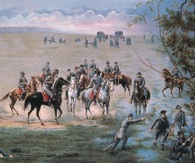ASK MHQ: Anything about military history you’ve always wanted to know? Submit your question, and we’ll ask an expert in the subject to answer it. You can even suggest the expert you’d like us to query.
Q: I have a question about the American Civil War. Did Gen. Robert E. Lee or the other Southern generals ever consider a direct attack on Washington, D.C., to end the war? It would seem to me that Lee was not averse to risk, and the Army of Northern Virginia usually got the best of the Army of the Potomac, so why did he go on the offensive at a place like Gettysburg and not Washington?
Leonard Glickman
Somerset, Mass.
A: Capturing Washington was a gleam in many a Confederate eye, but opportunities to do so were few and far between. The first chance came after the Federal rout at First Bull Run in July 1861—but the Rebels were as disorganized by victory as their enemies were by defeat, and once the Yankees rallied behind the capital’s rough-hewn defenses, the chance was lost.
When the Union’s Army of the Potomac fought its way up the Virginia Peninsula toward Richmond in the spring of 1862, there was talk in Confederate circles of a hit-and-run raid on Washington, but it remained just talk. By that point the capital was well on the way to becoming the most heavily fortified city in the world.
 After his victory over Maj. Gen. John Pope at Second Bull Run in late August 1862, Lee had his army just twenty-five miles from Washington. But Pope’s troops fell back behind the formidable defenses, and Lee lacked the manpower and the heavy weaponry to dislodge or besiege them. He launched his first invasion of the North instead.
After his victory over Maj. Gen. John Pope at Second Bull Run in late August 1862, Lee had his army just twenty-five miles from Washington. But Pope’s troops fell back behind the formidable defenses, and Lee lacked the manpower and the heavy weaponry to dislodge or besiege them. He launched his first invasion of the North instead.
After Lee’s victories at Fredericksburg in December 1862 and Chancellorsville in May 1863, the Federal army—bloodied but unbowed—still blocked the path to Washington, and could still take refuge in the defenses if need be. During the Gettysburg campaign, Maj. Gen. Joseph Hooker and then Maj. Gen. George Gordon Meade were careful to stay between the Confederate invaders and the capital. Cavalryman Jeb Stuart did come as close as Rockville, Maryland, but Washington’s defenses discouraged any thought of a raid.
July 1864 saw the most serious threat to Washington. Lee, besieged at Petersburg, sent Lt. Gen. Jubal Early north into the Shenandoah Valley. Early swung east from the valley through Maryland and reached the Washington lines at Fort Stevens, north of the city. But Ulysses S. Grant dispatched VI Corps from Petersburg, and it reached the capital in time to discourage Early from attacking.
President Abraham Lincoln witnessed the skirmish from a parapet at Fort Stevens. Historians say the story that Oliver Wendell Holmes Jr., future justice of the Supreme Court, yelled, “Get down, you fool!” at the president as the bullets flew cannot be authenticated. It’s a good story anyway.
MHQ contributing editor Stephen W. Sears has written several books about the American Civil War, including Gettysburg and Landscape Turned Red: The Battle of Antietam.




